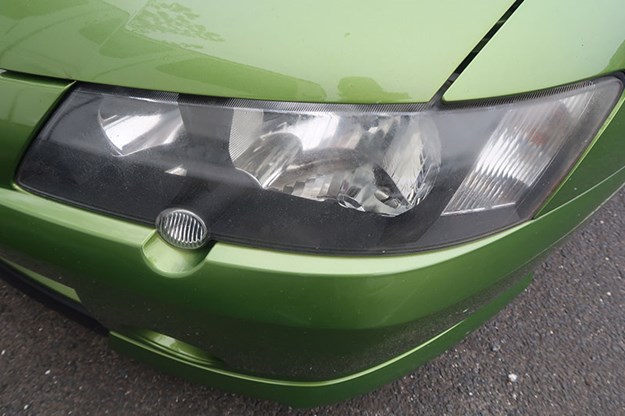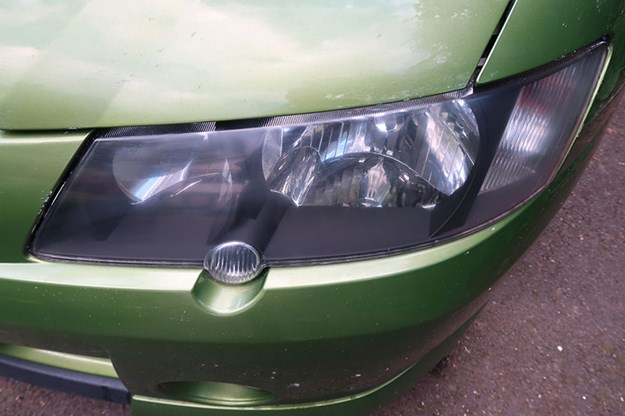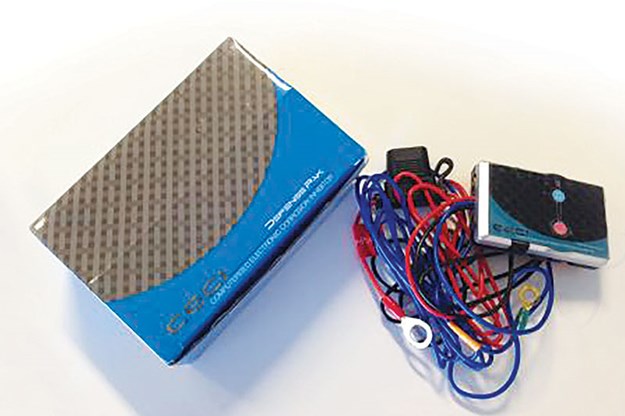Drag strips, headlights + flying machines - Morley's Workshop 419



|
And which racetrack were you conceived at? Morley gets way too much information
MORLEY'S WORKSHOP
Dressing up the tow pig
The Melbourne Bloke Centre has a new tow-pig. I finally got sick of not having cruise-control and air-con (not to mention that the old tow-car was a manual… not so good for dragging tandem trailers around) so I stuck it online and had a bloke buy it, fly down to the MBC, pay me cash and drive the old girl home about a neat thousand kays. He phoned me 24 hours later to tell me that she ran perfectly and to say how happy he was with her. Nice. I like a happy ending.
So anyway, there I was with no tow-truck in the driveway. I considered my options. One idea that popped into my head was to buy an early Porsche Cayenne. These first-gen models had an atmo V8 and a transfer-case with low ratios, so I could even use it off-road if I wanted to. And man, they are cheap considering the Porsche badge and the level of kit you get in a car that is still really only about 15 years old at the outside. I also have a bit of history with early Cayennes, too: I rallied a factory-prepped one across Russia and Mongolia in 2007 and 2008 in an event called the Transsyberia Rallye. The first year was a wash-out when the car wound up at the bottom of a three-metre ditch, but in 08, we finished – I think – 13th outright.

Ultimately, though, the thought of something expensive going pop turned me off the idea, as did the fact that I already have an off-roader. Also, shovelling half a cubic-metre of topsoil into the back of a Porsche just doesn’t seem right. So I turned to my suburban past and followed my bogan instincts. And I bought another Holden Ute.
This one’s a VY SS in lovely Hothouse Green and it’s an auto with leather and an aftermarket head unit that includes Bluetooth. And it also came with discoloured, cloudy headlights courtesy of a decade-and-a-half of Aussie UV. Now, I know you can buy kits designed to rejuvenate yellowed headlights, but these were beyond that. Felt like the polycarbonate lenses had been sand-blasted AND yellowed.

After asking around, it turns out that good old fashioned wet-and-dry and an aluminium polish can do the job. The first thing to do is mask off the painted areas around the headlight (duh) and then start with 1200 wet-and-dry before working down to 2500 or even 3000-grit. Then, you slap a bit of polish on a rag and give the lenses a final buff. To be honest, the end result isn’t brand-new, mirror-finish stuff, but at least the car doesn’t look like it’s been driven through pea-and-ham soup lately. And I’m told that a quick shot of clear two-pack paint will seal the lights and make them even clearer. So that’s next. For the moment, though, I’m calling it a success and doing the mechanic’s victory dance down at the MBC.
HERE'S MY TIP:
Always buy quality

I was reminded of this the other day while masking off the headlights on the MBC tow-truck: Always use quality masking tape, and don’t leave it on any longer than you need to.
That’s especially true when you’re wet sanding, as the water will turn the tape (particularly the cheap stuff) into a claggy mess that wants to leave its adhesive all over the paint. Some punters have even had the clear-coat lift when they’ve removed the tape after leaving it too long. That’s learning the hard way, right there.
What, no courting burnout?
 LCT is a money grabbing exercise by the Canberra swamp-dwellers who never protected the industry
LCT is a money grabbing exercise by the Canberra swamp-dwellers who never protected the industry
My name is Peter. I was born in the 1950s, so we share the same time capsule. Rumour has it I was conceived in a drag car during a race at Willowbank Drag Strip, with the rear tyres on fire. Dad was not one for foreplay.
Now that the (somewhat awkward) introductions are out of the way, I need to ask a couple of questions. Firstly why are car magazines avoiding the discussion we all need to have regarding the senseless continuation of the Luxury Car Tax? Our beloved motor industry is now history, so what are we protecting?
Rumour has it that a free-trade agreement (with Australia) may soon be on the table for both Europe (EU) and the UK in the foreseeable future, possibly next year. Before that happens, I strongly suspect that the German and English governments (in particular) will insist on Australia agreeing to abolish the LCT which, incidentally, adds incrementally to the cost of each car above $67,000 for no good reason.
We have to assume that these governments will not be happy with us if we continue to impose a senseless tax on their vehicles with Germany (home of Mercedes, VW, Audi, Porsche and BMW) and England (home of Jaguar, Aston Martin, Lotus, Morgan etc) selling many thousands of cars each year in Australia, subject to that tax.
I know many car companies (not to mention private individuals) have been lobbying for the abolition of the tax since our motoring industry closed its doors, but without success. Soon, hopefully, the power of foreign governments will be enough to finally bring an end to the dreaded LCT.
Secondly, what impact is the Queensland Government’s Luxury Vehicle Tax having on sales of vehicles (not just cars) over $100K since its introduction on July 1. Anecdotal evidence suggests that some people (especially those closer to the border, which is all of south-east Queensland) are travelling interstate to avoid the tax. Common-sense would confirm this, which means that Queensland car dealers will be heavily impacted, as it’s the luxury car market where the biggest profits are. By far.
Peter Neilen,
Nambour, QLD
Jeez mate, awkward ain’t the word. But I reckon your parents were lying to you: Willowbank was only built in 1985. So maybe the old Surfers Paradise drag strip was the venue, and that’s why they changed their story: Nobody wants to admit to being conceived on the Gold Coast. And as for me… don’t be fooled by the grey beard; I was hatched in the 60s.
Meantime, I’m with you all the way on the LCT. When you crunch the numbers, it’s pretty clear that the Feds make more from the sale of any, say, Porsche 911 than Porsche Australia ever does. And somehow, that just doesn’t seem right to me. It also occurs to me that the Constitution of this fine, brown land includes the proviso that a citizen shouldn’t be taxed twice on the same dollar. So, if I’ve worked hard, earned my money, paid income tax on it, how then can the Capital Circuit swamp-dwellers tax me some more on that money just because I’ve been a good boy, toiled honestly and chosen to treat myself? Again, doesn’t sit right with me. And let’s not forget that we don’t have a Luxury Boat Tax, or a Luxury Jewellery Tax or even a Luxury House Tax. Nope, it’s us tappet-heads that are being singled out for special treatment.
Which is all another way of answering your first question: Now that we don’t make cars here any more, what’s the LCT protecting? Well, the answer is simple: The Canberra coffers, is what.
You only need to take a look at the leadership shenanigans of recent months to understand that, once you step over the ACT border, logic ceases to come into it. Face it, if a small group of hard-line bozos and their media flunkeys can railroad our democracy to the extent we saw when ol’ Dead Eyes Dutton mounted his charge for the big chair, then anything is possible provided you’re coming from a sufficiently deluded position.
Meantime, the idea of driving across a State border to buy something you can’t get at home (like a tax-break) is nothing new. For years, bus companies operated tours from Melbourne up to the border towns on the Murray River where, once safely inside NSW the passengers could pour their pay-cheques into the one-armed bandits a coin at a time. And let’s not forget that lots and lots of people once travelled interstate to get things that were legally unobtainable at home: As in, fireworks and brothel tickets. And where did they go for such tasteful pursuits? Yep, Canberra. Typical. Makes your dad look like a hopeless romantic.
On the busses – again
 Smooth running big Benz motors are pearlers
Smooth running big Benz motors are pearlers
Just been reading issue 414 about the Clipper bus and its demise. Shame about the old dear. They’re very scarce now. Pioneer stepped up later and started using MCIs (busses) on their runs and I have a 1976 MCI Mark 8 Crusader which still runs an 871 Detroit, otherwise known as the screaming GM. Driving that thing, I am king of the road.
It’s always been ultra-reliable and I believe Pioneer policy was to replace the motor and gearbox around 750,000 miles. It was all done on a slide-out; a few hours later and back on the road. None of these MCIs were retired until between seven and nine million kilometres.
Mercedes OM355 motors rated at 240 horsepower were used in wooden pearling luggers. A very smooth motor. Some of the other big brand motors used to vibrate the screws loose. Not really ideal when at sea.
For those who don’t know, when it comes to two-stroke GM engines, the numbers say it all:
The last two numbers were the size of each pot (53 cubic-inches, 71 inches, 92 inches) and the first number was the number of cylinders. Hope somebody finds that interesting.
Rob,
Proston, QLD
Wow, 750,000 miles from an engine and gearbox and somewhere between seven and nine million kays for the bodyshell. Makes a Toyota taxi look like an amateur, doesn’t it. You make and interesting point, Rob, about an engine’s smoothness being important in a wooden boat. I hadn’t thought about that, but when you see it written down, it makes all sorts of sense.
My own experience of a Benz car engine doing marine work was in Thailand where I hitched a ride on one of those long, narrow boats that go up and down the rivers, canals and channels in Bangkok. Typically for the breed, this was a six-cylinder car engine, mounted on a pivot with a long prop-shaft driven straight off the flywheel. The pivot was carefully located so that the engine was perfectly balanced, important because the whole engine was articulated and swung around and up and down as part of the tiller.
To stop, the bloke simply titled the whole motor, lifting the prop out of the water and to go again, the prop was dropped back into the water. To hear those engines free-revving with the prop in mid-air, through a straight-out exhaust system was something else. Probably doesn’t happen now, but it was just part of Bangkok life 20 years ago.
Things I see. And hear
Morley, a sign I saw in the Q Transport office in Maryborough: Honk if you love Jesus. Text while driving if you wish to meet him.
While I’m at it, here’s a conversation I overheard at a barbecue:
Dad: I’m thinking about buying a new car, son. Can you help me with some of these new features?
Son: Sure Dad, fire away.
Dad: Okay, auto emergency braking?
Son: Well, that’s for if you aren’t paying attention to the road as you should be.
Dad: Okay, what about this Bluetooth?
Son: Well, that’s so you can use your mobile phone in your car legally.
Dad: How is it that using your mobile phone is illegal?
Son: It distracts the driver.
Dad: What’s an infotainment screen?
Son: Well, that’s a device that tells you where you are and entertains you.
Dad: How come one is legal and the other is illegal.
Son: Well, one is built into the car and one is portable.
Dad: What about lane departure?
Son: That’s a warning to the driver that the vehicle is in danger of leaving the lane it’s in.
Dad: Shouldn’t you be looking at the road and the lane you’re in?
Son: Not if you’re concentrating on the infotainment screen or your mobile phone.
Dad: And what are all these air-bags for?
Son: They inflate to prevent injury in the case of an accident.
Dad: Good God! I’ll have to stop calling your mother that.
Carl Wallent,
Somewhere, QLD
Carl, I sincerely hope Mrs Wallent never reads Unique Cars. But I sympathise with Dad trying to navigate his way through all this latest technology without a guide. Actually, it’s a very good point to make and I reckon the car-making world has got it a little bit backwards when it comes to introducing the latest high-techery.
See, traditionally, the latest , high-end and clever stuff has found its way into the super-deluxo models first. That’s because older, cashed-up buyers are the only ones who can afford it. But my contention is that they’re actually the last people who want it or will actually use it. Now, my old man is a product of his generation, which is to say pig-headed and short-tempered. Not to mention that he just doesn’t want to know about learning new things. So, for him, the latest sat-nav or infotainment screen would be about as useful as modern paddle-shifters. Sure, they work beautifully, but he’ll never bother to use them. Fact is, they’ll only ever distract him or annoy him that he had to shell out for something he doesn’t want to know about. For Dad, you see, Bluetooth was a pirate and Android is something you can get cream for at the chemist.
I‘m also quite certain dear old Dad would scratch his scone over the idea that a mobile phone in a cradle is fine to use on the run, but a hand-held unit is not. And as for needing lane-departure warning…well, that’d be another example of us fiddling with natural selection. (Actually, I’m kind of with him there. Just don’t tell him.)
One plane, four car engines

Needless to say I’ve been reading Unique Cars for many years and usually turn to Garage Gurus first up. Great reading.
There have been a number of interesting letters about alternative uses of car engines but as I’m both a car and aircraft enthusiast I though you would be interested in the use of four different car-based engines in one aircraft type. In 1919 two Australians, Ross and Keith Smith, with crew members Wally Shires and Jim Bennet were the first to fly from England to Australia in an ex- RAF Vickers Vimy, taking 28 days to cover the 18,250km to Darwin at an average speed of 137km/h and winning a prize of 10,000 pounds (around $150,000 in today’s money). The Vimy was a large WWI biplane bomber powered by two 20-litre (1,220 cubic-inch) Rolls Royce Eagle VIII V12 engines of around 360hp each. These engines were based substantially on the concept of joining two six-cylinder Rolls Royce Silver Ghost 40/50 automobile engines of 7.4 litre (451 cubic-inches) capacity and were the first V12 aero engines produced by Rolls Royce.
In 1994, a replica of the record-breaking Vickers Vimy was built with the aim of repeating its several record flights. Its first flight was from England to Australia piloted by Lang Kirby and Peter McMillan. In this form it was powered by two Chevrolet 454 cubic-inch (7.4-litre) V8s in NASCAR racing trim. Subsequently, these were replaced with BMW M73 V12 5.1-litre (330 cubic-inch) engines producing 321hp. The final version was powered by Orenda OE 600 V8s of 495 cubic inches (8.1 litre) and 600hp. These Orendas were developed from the GM alloy-block ZL1 CanAm engine and were intended to replace ageing Pratt and Whitney and Wright aero engines in older aircraft.
All of these engines were extensively modified with dual ignition and dual fuel systems to meet aircraft safety requirement. One final example is the use of Jaguar’s 5.3 litre (327 cubic-inch) V12 engine in at least one replica Spitfire.
Of course, we can then look at the use of aero engines in cars, but that’s a whole other story!
Colin Smeal,
Holder, ACT
Sounds to me, Colin, that you know your way around significant old aircraft. Joining a pair of inline engines to make a V8 or V12 is a thing I’ve heard of before, but I’ve never heard of anybody using Chevy 454s to get something into the air. But it kind of makes sense when you say it was the ZL1 version of the Chevy big-block, because these were actually all-alloy (where pretty much every other Chev V8 of the era was cast-iron).
At first I wondered about using the ZL1 in NASCAR trim, but then I thought back to the last time I watched a NASCAR race and saw the telemetry flash up on my TV screen. Essentially, these (admittedly more modern) V8s were being spun to 9500-plus rpm for lap after lap, while also dealing with running in somebody else’s slipstream (hot air) and hardly ever missing a beat..
The other thing that occurred to me when I read your letter, Colin, is that there is no way in a month of forevers that I’d be going up in a plane powered by a Jaguar V12. Just sayin’.
Useless is as useless does
You asked about useless car accessories… Utterly useless was the rubber strap hanging off the rear bumper, for purpose of arresting child car-sickness. Supposedly with a metallic strip in the rubber which directed the static electricity to the road. Problem was that the strap never made contact with the road unless the vehicle stopped.
Eric Waples,
Albion Park, NSW
Yeah, at which point the kid stopped feeling crook, right? Weird coincidence. I know from much experience that avoiding car-sickness is best achieved by avoiding cars. My little sister had a horrible habit of burping a rainbow within minutes of us taking off anywhere in the family Kingswood. It lasted for years until she grew out of it, but by then the damage was done and that HQ never smelled of anything but recycled Rice Bubbles ever again. I reckon it’s a similar situation to sea-sickness where the only accepted cure is to sit under a tree.
Cheery, but useless

Morley, you asked about the most useless automotive accessory of all time. Well, I’ve still got it adorning the firewall of my Nissan Patrol. Yes, a little blue box masquerading as an "electronic rust proofing" device. It cost me $700 in 2001 and has been happily illuminating its near vicinity with a red glow from its little bulb for the last 17 years.
Over that time, however, I’ve had to scrape rust scale off a chassis rail that is connected by wires directly to the blue box (I won’t name the brand, but they’re all terminally useless). These devices obviously don’t affect the development of rust, but they do provide a cheery red glow each time I raise the bonnet. I hear they can also be used as Polarizers.
Paul Hanna,
Email
Yeah, but imagine how rusty that chassis rail would be by now if you didn’t have the magic box! I’m seeing the cartoon strip where the bloke is on a bus spraying elephant repellent around. "There are no elephants in Australia," says a fellow passenger. "I know," says the bloke "Effective, isn’t it?".
Dad jokes aside, Paul, this is interesting because I was hoping there might have been some science to the whole electrical-current-preventing-rust thing. Not according to you, however. As it turns out, similar devices were effectively banned from sale by WA’s consumer protection authority in 2015, on behalf of governments nationwide. The conclusion reached by the department, after independent testing, was: "In fact the ‘science’ behind the claimed protection simply cannot work in this scenario. For unwanted rust to be attracted to a sacrificial piece of metal using positive electrical current requires the negatively connected rusty metal to be in a conductive solution, so essentially the vehicle would need to be constantly submerged in water."
Convert and be happy

Look forward to your column each issue. Loved the five-litre Iron Lion ignition lead story. Got caught out big time on that one when doing the leads on my VR Statesman. After a hard night on the amber stuff, it took me a whole afternoon! Cracked up when I read your story, every bit true.
Another one: Have you ever tried to change the clutch on a MKII, two-litre Escort? Another pain of a job. I found the solution, get an automatic version and convert it to a manual. The automatics have a different transmission tunnel; a lot bigger. I have a MK II Escort van, automatic originally which I put a two-litre Pinto and Toyota Celica cast-iron five-speed into. Plenty of room.
On a final note, I have just purchased one of the last WN Caprice Vs, LS3 and a rare colour in Empire Bronze. Is there any way of finding out how many were made in this colour?
Brent Murray
Nice to know I’m not the only knuckle-head who finds everyday stuff like changing plug leads a challenge. I haven’t had to do a clutch in a Mark II Esky, but my own, personal beef with the designers of this fine, family transport module is that the camshaft has to come out through the rear cam bearing. Which means you either remove the dashboard, use a hole saw to permanently maim the firewall and drag the bumpstick out through the interior, or you pull the whole head off. I’ve done a couple of these now, and while whipping the head off is the logical solution, you’ll still find yourself standing around in the garage, scratching your bum and wondering aloud if it needed to be this complicated.
As for your Caprice and its relative rarity, I reckon you’d need to talk to somebody at Holden regarding build numbers. Maybe somebody from one of the relevant car clubs would know, too. Bueller? Bueller?
TRIVIAL PURSUIT
Paint it black

I know it’s a personal thing, but I’m not a fan of black cars.
I owned one once and it was like the Harbour Bridge: You started cleaning it at the front and by the time you got to the back, the front was ready for another wash. Meantime, they disappear at night and in strong sunlight, they lose their shape and become big, fuzzy, black blobs. But some cars just look ’right’ in black.
I’ll kick this off by naming mine: The Jaguar Mark 2 and a 1960s or 70s Toyota Crown. Any other nominations? Photos are more than welcome, too.
Out in the hoodie

Anybody out there with kids old enough to drive but young enough to wear a hoodie while they do it? Perhaps one of them could explain to me the recent phenomenon of the door banner? In case you’re sane and not drug affected and, therefore, not with me here, a door banner is a decal that is placed on the lower portion of the doors of a – typically – 15-year-old Holden Commodore V6. They display messages proclaiming the car in question to be `Eye Candy’ or, even more perplexing, advertising some clothing or beverage company that – as far as I know – is not paying for this advertising space. Got me buggered.
Write to Morley c/o uniquecars@primecreative.com.au or Unique Cars magazine, 379 Docklands Drive, Docklands, Victoria 3008
Unique Cars magazine Value Guides
Sell your car for free right here
Get your monthly fix of news, reviews and stories on the greatest cars and minds in the automotive world.
Subscribe


.jpg)








.jpg)



